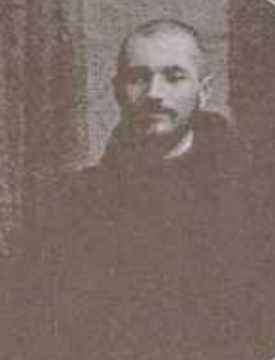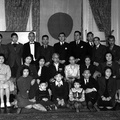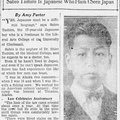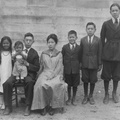In June 1938, Urbain-Marie Cloutier/Yonekawa was sent to Peru. During his time in Alexandria, Egypt in the mid-1930s, Yonekawa had made friends with Seitado Kitada, the local Japanese consul. When Kitada was appointed Japanese ambassador to Peru, he took up the role of advocate for the Japanese Community in Peru. In order to help the Issei adapt to their new society, Kitada urged them to convert to Catholicism, as it was the official religion in Peru. According to one source, Kitada personally addressed a letter to the Vatican to ask the authorities to send to Lima a Catholic priest who could speak Japanese.
In 1935, Father Calixte Gelinas was selected to run the new Peruvian mission, opened in a small house in Lima. Gelinas, a Franciscan from St. Barnabe, Quebec who was ten years Yonekawa’s senior, had taken up missionary work in Japan (as did his brother and fellow priest Conrad Gelinas) before World War I, learned to speak Japanese, and become a naturalized Japanese citizen. Once arrived in Lima, he took up teaching catechism to children.
Once Yonekawa arrived two years later, he joined forces with Gelinas, and he translated catechisms and books from Spanish into Japanese. The two taught students at the Lima Nikko School and opened a house of welcome on Avenida Arenales in the Parish of Santa Teresita del Nino Jesus.
In early 1939, Yonekawa joined in celebrations held at the Japanese School to mark the Jubilee of Sister Frances, a Sister of Charity who had spent 32 years working at the Dos de Mayo Hospital. Yonekawa preached a short sermon in French, Spanish, and Japanese for the occasion. Around this time, Yonekawa and Gelinas also contacted Japanese congregations in Tokyo and had asked them to send nuns as teachers at the school, but were unable to secure any before the Pacific War broke out.
By this time, the Japanese community in Peru (made up of some 25,000 Issei and an approximately equal number of Nisei) was increasingly embattled. In 1936 and 1937, a set of discriminatory laws enacted by Peru’s government barred Japanese immigration and forbade children of immigrants whose birth had not already been registered from acquiring citizenship.
In May 1940, following an extended period of hostile propaganda, an anti-Japanese demonstration in Lima (the so-called “Saqueo”) broke out into a pogrom. During three days, rioters looted and damaged some 600 homes and businesses of Japanese Peruvians, while police and government forces refused to intervene.
In December 1941, following the Japanese attack on Pearl Harbor, the U.S. declared war on Japan. Although Peru did not officially declare war in Japan until February 1945, Peruvian authorities collaborated with the U.S. State Department throughout the early months of the Pacific War in identifying Japanese community members for roundup as potential subversives. Ultimately some 1800 ethnic Japanese businessmen and community leaders and their family members were rounded up by the Peruvian government and deported to the United States.
Meanwhile, the government enacted drastic measures against Japanese residents. The government seized “enemy-owned” businesses. Peruvian authorities issued decrees forbidding ethnic Japanese to gather in numbers of more than five. or to leave the city of Lima without a written police permit.
In the wake of these measures, Yonekawa emerged as a leading defender of the Japanese community. First, he submitted a letter of complaint to the government about the restrictions on freedom of assembly, and arranged with the police to serve as guarantor and to permit the Japanese Catholic mission to resume its activities. Pope Pius XII, upon learning about the situation of the Japanese Catholics of Peru. sent funds that Yonekawa personally distributed to needy parishioners.
According to one source, “Padre Calixto” and “Padre Urbano” visited various Ministries in a vain effort to persuade the authorities of Peru to not expel the Issei rounded up by the government, and even risked their own lives by hiding some of the leaders, but this is unconfirmed. He and Calixte launched the “Saint Francis Committee,” with the goal of providing charitable and social support to the Japanese community, including distributing food, organizing community meetings and collecting private donations.
In the years after the end of World War II, Yonekawa was named Superior of the Convento San Antonio de Lima, which was created as a mission to the Japanese in Peru. As the congregation parish grew to 8,000, Yonekawa supervised the expansion of the Japanese mission building into a new structure, St. Anthony of Padua, which was made up of a church and monastery built in the Spanish colonial style. “We had to build them ourselves, with the help of Canadian alms: Peruvians are not accustomed to help,” Yonekawa said.
Yonekawa and his fellow missionaries also worked with other populations in Peru. First, in 1944, the Franciscans, assisted by Sisters of Our Lady of Angels, an order of nuns from Sherbrooke, Quebec, assumed care of 500 Hansen’s Disease patients in San Paulo. Yonekawa told an interviewer, “Before we came here, at the request of the Peruvian government in 1944, lepers were left to die in the forests. Even now, they are forced onto rafts like beasts and put adrift in the river to come to San Paulo. But we are getting results with our treatment.”
In the postwar years, Yonekawa also assisted with missionary work among native peoples in the Peruvian Amazon. In interviews, he expressed a rather paternalist vision of the native peoples he served: “They are so primitive, and they do not want to be civilized. But they do not steal…they are like smiling children.”
The Franciscans opened 10 missions in the Amazon, and Cloutier led a team of 13 Franciscan fathers, three brothers and 10 lay helpers. They worked despite suffering from stifling heat and bouts with tropical disease. “Our workers become thin, disease-ravaged,” said Cloutier. “It is necessary often to bring them to Lima to rest.”
In 1953, Yonekawa was decorated by the Japanese government with the Fourth Order of the Sacred Treasure. It was awarded him in recognition of his support for Japanese Peruvians and for his work building better relations between Peru and Japan. Yonekawa travelled to Japan for the ceremony.
While en route, he made a stopover in Montreal, where he had not visited for 15 years. There he met up with a young Japanese Peruvian, Sotélo Kato, whom Yonekawa had previously converted to Catholicism in Peru, and who had moved to Montreal to study for the priesthood.
Following the ceremony in Tokyo, Yonekawa returned to Peru and took up his work (Father Calixte died in June 1953, so Yonekawa was now the elder). During the following years, in addition to his pastoral duties, he undertook a two-volume history of Japanese Peruvians, Lumière nippone au Pérou, which was published by the Éditions Franciscaines publishing house in Quebec at the end of the decade.
The first volume, Aube naissante et grandissante 1905-1953, appeared in 1959. It was followed the year after by the second volume, Lumière fulgurante et resplendissante. His last book, Esquemas de homilias dominicales. a selection of his Spanish-language sermons, was published in Lima in 1960.
In 1961, Masanori Yonekawa/Urbain-Marie Cloutier retired due to illness, and returned to Canada. He died in February 1965 in the provincial infirmary of the Franciscans at Montreal. Only one small provincial newspaper marked his passing with an obituary.
Although his books have fallen out of print and his varied career has been obscured by the passing of time, Cloutier/Yonekawa was remarkable for his dedication to the Franciscans and for his wide-ranging interests, including writing and speaking in four different languages. He stands as a representative of several generations of French Canadian missionaries who gave their lives to serve the Church in a variety of positions, and who helped shape the lives of people around the world to whom they dedicated their missions.
© 2024 Greg Robinson






